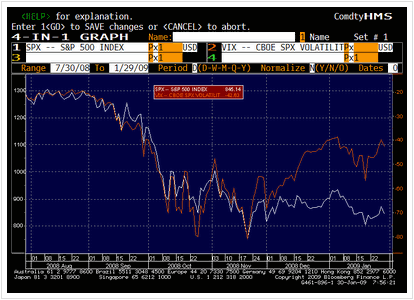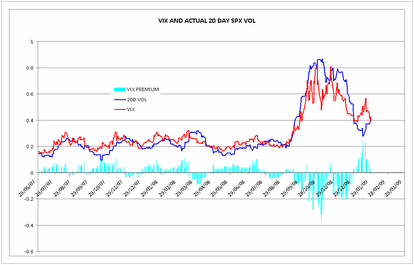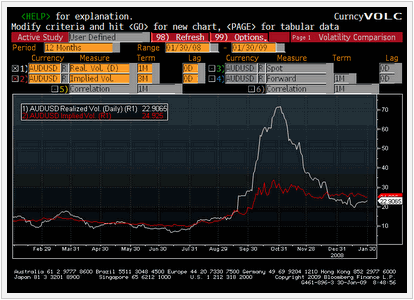It’s been a bit of a weird month, hasn’t it?
For Macro Man, the last couple of weeks have really dragged by (including the always-crushing error of mistaking Wednesday for Thursday)….and yet he is shocked that we’re at the end of January already. Talk of loving risk and a the five-day rule seem like a long, long time ago.
Such is the difference between micro and macro….quite often, when focusing on the one, it’s easy to lose sight of the other. Macro Man, as the name implies, typically focuses more on the macro side of the equation; as the saying goes, the name does exactly what it says on the tin.
But if it seems as if his macro musings are less interesting than usual- and judging from the relatively low number of comments this month, you have- he is not surprised to hear it. While Macro Man has focused a bit on macro issues this month- the collapse in global trade and the potential onset of protectionism (a long-held theme for him), in his real world book he has become much more of a micro man this month.
To be sure, he has allocated capital to his favourite thematic trades and done OK by them. But there has been quite a bit of noise in these trades, relative to the net directional signal. And there have been good, fairly directional macro trades that he either missed (long the front end of Europe early in the month) or got wrong (the equity dump into the inauguration.) So Macro Man has found imself doing an unusually large amount of shorter-term trading to pay the bills, so to speak, while his longer-term macro bets percolate on the stove. It’s not his core methodology, but if markets are going to be noisy than it behooves him to try and trade the noise.
One of the other reasons for his stronger emphasis on micro, rather than macro, is the relatively unattractive pricing of options. Macro Man typically likes to articulate his views via options becasue a) they offer significant leverage, b) the strategies that he employs allow him to articulate a defined loss parameter, and c) they allow him to play for the signal rather than getting shaken out by the noise.
So in the current environment, they should be ideal, given how noisy things are; in the past week, for example, AUD/USD has traded from 0.6425 to 0.6725 and then back again. And on the face of it, options on “risky assets” might look cheap. A simple overlay of the SPX and VIX, for example, would suggest that implied index vol should be closer to 70 than 40.
However, this ignores the fact that options decay, and the longer you remain in the same range, the more unprofitable owning options ata given volatility will become. Given that the SPX first traded at yesterday’s closing level on the 10th of October, it’s not surprising that implied vols have come lower.
Digging deeper confirms Macro Man’s suspicions that options have been expensive, not cheap. Plotting the VIX against realized 20-day annualized vol in the SPX yields some pretty interesting results. If we look at the gap between realized vol and VIX, we can see that implied vols were actually lower than historical vol throughout the teeth of the crisis in September-November. This year, despite the lower level of VIX, implieds have still traded at a premium to the actual volatility in the market. So Macro Man’s intuitive sense that optins have seemed expensive looks to have been correct; small wonder he’s found difficulty in structuring attractive looking trades, in contrast to Q3 and Q4.
A similar development is evident in the currency space, where AUD/USD vols, for example, now trade above the level of historical vol after trading at a substantial discount late last year. While it is of course future, rather than historical, vol that is the real basis of comparison to implieds, it’s difficult to extrapolate an uptick in realized vol while so many asset prices remain within the ranges established over the past few months.
An obvious alternative strategy is to sell vol. However, Macro Man has found that bid/ask spreads on bounded-risk short vol strategies (butterflies, barrrier ptions) have rendered those unattractive as well. There’s no point buying a barrier option if you are effectively selling vol at 19% rather than the 24% mid-market vanilla implied.
Given his gloomy worldview, Macro Man has little interest in unbounded-risk strategies like selling straddles and strangles. So he’s left keeping some risk in his favourite macro trades (while remaining poised and ready to add aggressively when they come into play)….but for the most part, spending his time on the micro, trying to use the noise to his advantage.
- Bulenox: Get 45% to 91% OFF ... Use Discount Code: UNO
- Risk Our Money Not Yours | Get 50% to 90% OFF ... Use Discount Code: MMBVBKSM
Disclaimer: This page contains affiliate links. If you choose to make a purchase after clicking a link, we may receive a commission at no additional cost to you. Thank you for your support!





Leave a Reply